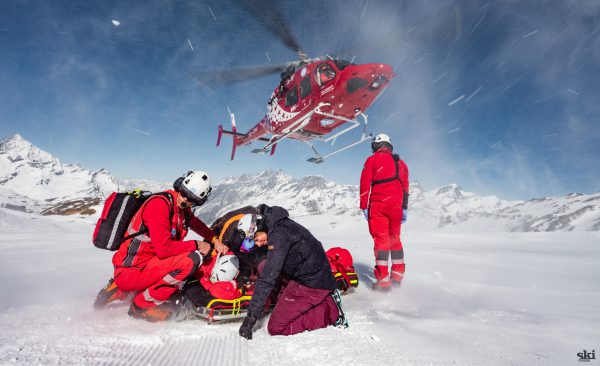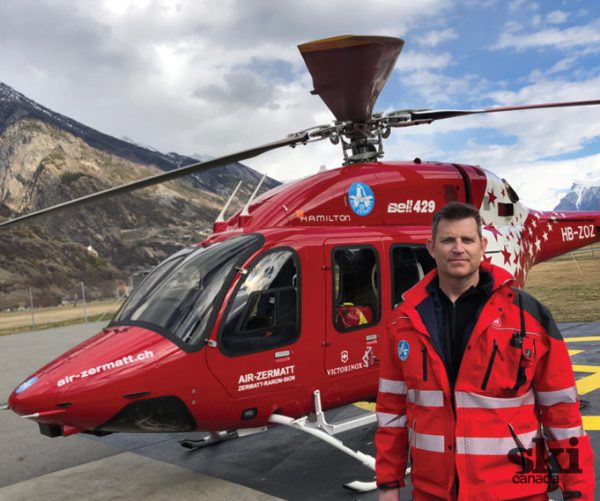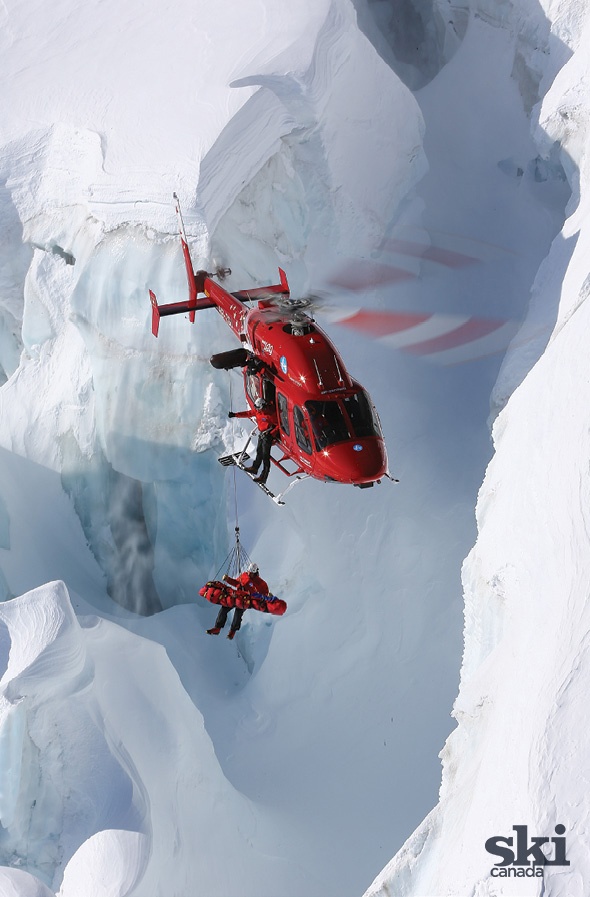Ski Canada’s John Foote MD spent a day in the rescue helicopter with the Air Zermatt crew

I’ve seen you on TV!” an American accent blurted out as I, now red-faced, passed a group of curious onlookers. I’d just exited the Air Zermatt rescue helicopter that had landed dramatically near a gondola’s exit station. Although I’m an ER physician and I was wearing the rescue team’s logo’d jacket (as seen on the Netflix and RedBull TV show The Horn), it was only a day of observation for me. Still, this poser wasn’t going to admit anything; there was work to be done, or at least observed.

Dr. Foote: “I was warned not to touch any buttons on the Bell 429”
After watching episodes of The Horn on my comfy basement couch at home, I was bit apprehensive about spending a day riding shotgun with a media-savvy Air Zermatt helicopter crew, but Editor Iain announced he’d somehow secured me a seat so it was game on. Would they expect me to rappel down a crevasse to help rescue an injured skier? Intubate a victim in the alpine or perhaps dangle beneath the flying helicopter in a basket rotating with a patient strapped inside?
Fortunately for the injured skiers who were airlifted from the various ski hills in the Valais or Wallis cantons of Switzerland on my day with them in March, the expert team was warm, welcoming and had no expectations of me. Flying out of Air Zermatt’s Gampel base (one of three), Swiss rescue pilot Thomas Pfammafler as well as paramedic and hoist-operator Dario Gobba both work full time at the job along with 63 others. German flight physician Michael Scheiwein rotates duty with visiting anaesthesiologists, ensuring every rescue has a qualified MD on board.
After Dario had fitted me into the official Helly Hansen uniform, I was instructed on proper aircraft etiquette—and warned not to touch any buttons on the Bell 429 chopper. We didn’t have to wait long for our first call to the slopes near the neighbouring resort of Saas Fee. A journey by car and train that would have taken hours would instead be flown in minutes.
The scenery from Gampel to Saas Fee on a bluebird day was spectacular. Thankfully (I think) my helmet and wraparound visor helped hide my awestruck facial expressions. We landed near the top of a gondola station where, aside from the paparazzi, we were met by the local ski-patrol team who had already stabilized and prepared the injured skier for transport. Within five minutes of our arrival, Dr. Scheiwein had already relieved the patient’s distress by starting an IV and administering a strong analgesic. It obviously helps that he is a trained anaesthesiologist, a medical discipline generally considered to be the most qualified in Europe where Emergency Room medicine is still a relatively new specialty. With the patient more comfortable, paramedic Dario then took over by gently moving the injured woman via stretcher to a safe spot inside the helicopter.
After a 10-minute flight, we landed on the roof of the Oberwallis Hospital Centre in Visp and delivered the patient to the waiting medical team in the Emergency Department. We learnt later that she had suffered a broken hip during her fall and had undergone successful emergency surgery that same day. I couldn’t help imagining the long uncomfortable transport first by toboggan and then by land ambulance that would have occurred without the Air Zermatt option.
After our return to the Gampel base from Visp, we proceeded to another important part of the Air Zermatt day: lunch! Just enough time meant a very civilized hot spread of Wiener schnitzel and hearty soup, but it wasn’t long before we were back in the air. This time, we were collecting an injured skier from the resort of Grimentz in the French-speaking part of the Valais from where I’d travelled by car and train for almost two hours earlier in the morning.
On this rescue and subsequent ones, there was no safe place for the helicopter to land near the injured skier, so Thomas, our skilled pilot, dropped the crew and then flew a few kilometres in wait. When the patient was packaged and ready for pickup, Thomas returned to the scene and hovered briefly close to the slope while Dario and Dr. Scheiwein lifted the patient into the cabin. Then back to the hospital in Visp in the picturesque Rhône Valley.

This process was repeated several times over the afternoon in a very orderly fashion. All of the injured skiers had suffered from serious orthopaedic injuries, which reflects well on the triage and selection process. I was impressed by the fact that the staff was able to communicate with injured skiers in many languages. In this case, Swiss-German, French and English were all spoken fluently with injured skiers.
As well, the ability to administer potent intravenous pain medication to seriously injured patients during transport to hospital was impressive, and was done by the Air Zermatt crew for all of the encounters that I observed. I was also impressed that none of the injured patients was treated with universal spinal precautions. In my opinion, the indiscriminate use of spinal boards and rigid neck collars during the transport of injured patients causes unnecessary discomfort and sometimes harm to many patients in North America.
Mountain rescues and emergency medicine can involve extreme and unpredictable weather, high altitude and limited resources; I seemed to have started with the “Gold Standard” as far as an accessible and efficient air transport system for injured skiers. Unfortunately for Canadians, the relatively large distances between our major ski resorts would likely prevent a similar system from flourishing here. With tens of thousands of missions since the operation began in 1968, Air Zermatt is the first of its kind. Little wonder many similar programs have been modelled on it.
And no, I didn’t get to keep the jacket.



